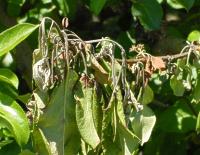

Younger plants are also more prone to fire blight damage, since they grow faster than established trees.įire blight infection is also more likely under ideal conditions:

Infection is more likely on plants injured by wind, hail, or insect damage. They can spread the disease to other plants. Honeybees are attracted to the sweet, sticky ooze that comes from trees infected with fire blight. Pink, orange, or red streaks on infected wood under bark.Dead black leaves and fruit that stay on the tree after death (making it look “burned”, hence the name).Wilted shoots that bend downward (causing a “hook” appearance).Water soaked, dull, gray flowers with ooze droplets in high humidity.

Wilted flowers (black on pear trees, brown on apple trees).Shriveled flowers, shoots, or fruit in spring (fruit turns dark and dry, looking “mummified”).Dark streaks on branches or trunks (where the ooze flowed and was exposed to air).This ooze is sticky and sweet, attracting insects that will spread the disease. A light-tan colored, watery “ooze” flowing from cankers (dead bark patches that are black, grey or violet) on twigs, branches, or trunks.What Does Fire Blight Look Like? (Fire Blight Symptoms)įire blight causes several telling symptoms you can look for to identify it on your plants: It is most likely to affect pear trees, but it can also affect apples, crabapples, raspberries, quinces, and others. What Causes Fire Blight?įire blight is caused by the bacteria Erwinia amylovora. In some years, 5 to 10% of orchards are affected.įire blight exists in Canada, several states in the U.S., and in other countries around the world. It often leads to thousands of trees being removed to prevent the spread of the disease. It is contagious and can spread to other trees in your yard unless you take steps to prevent it.įire blight poses a big threat to growers with apple and pear orchards. Join 1000 like-minded gardeners and get access to news, tips, and information.ĭelivered right to your inbox each Friday.įire blight is a disease that affects apple trees, pear trees, and other members of the Rosaceae family.
Apple trees resistant to fire blight how to#
We’ll also talk about how to prevent fire blight and how to choose trees that resist its effects. In this article, we’ll talk about fire blight, including what it looks like and how it spreads. Fire blight can destroy tree limbs or the entire tree in severe cases.Īlthough there is no way to cure fire blight, there are ways to prevent the infection and slow its spread in your plants. It can spread by splashing water or by insects (including honeybees) – more so in warm, humid conditions. So, what is fire blight? Fire blight is a bacterial disease that affects apple trees, pear trees, and other members of the Rosaceae plant family. If your apple or pear tree has oozing cankers, shriveled black flowers, dead leaves, or wilted shoots, you might have a problem with fire blight.


 0 kommentar(er)
0 kommentar(er)
